Author: Steve_4P, fourpillars; Translation: LianGuaixiaozou
Main Points of this Article:
· Following the Terra and FTX incidents, the blockchain industry has undergone market reforms centered around Ethereum and rollup networks.
· In this market situation, the Sei network claims to be a fast monolithic L1 chain.
- PYUSD appears to be a stablecoin, but is it actually a tech giant’s version of CBDC?
- In-depth analysis of the LSD track Why is Lido still considered a promising object?
- Dialogue with Mysten Labs Chief Economist How to design appropriate network economic incentive measures?
· Ultimately, for a blockchain to succeed, a large number of users need to be able to use it easily, which places high demands on scalability and chain stability.
· The Sei network has developed the Twin Turbo consensus mechanism to achieve the fastest finality time in the world while maintaining stable operation.
· Now, with the imminent release of the mainnet, people are very interested in what kind of performance the Sei network can provide.
1. Latest Trends in the Blockchain Industry – Sei
The mainnet release of the SEI network is imminent, making it one of the fastest blockchains in the world and a leading monolithic blockchain. SEI network, which has been postponing its mainnet plans until now, announced on August 1, 2023, that SEI will be listed on Binance’s launchpool, the world’s largest exchange. In addition, Binance will list the Sei network token SEI on August 15, officially confirming that the mainnet release of the SEI network is not far away. As the mainnet release of the SEI network is approaching, let’s briefly understand the SEI network and its concepts and latest achievements.
1.1 The Era of Rollup
Following the Terra and FTX incidents, the blockchain industry has undergone market reforms centered around Ethereum and rollup networks. Terra and Solana, positioning themselves as competitors to Ethereum, either went bankrupt or suffered significant setbacks, and the viewpoint that “there is no need for new L1 blockchains” became the mainstream. This market situation will only further strengthen the already powerful Ethereum ecosystem. With more power flowing into the rollup-centric multi-chain ecosystem adopted by Ethereum, the period from 2022 to 2023 can logically be called the “era of rollup”. During this period, rollup chains, L2 solutions, and several modular blockchains have received great attention. Let’s take a look at several representative projects among the many rollups:
1.1.1 Optimism and OP Stack
OP Stack received great attention when Coinbase, one of the world’s largest exchanges alongside Binance, deployed its BASE Chain using OP Stack.
OP Stack is an open-source code that provides the ability to build Optimistic Rollup. Using OP Stack, rollups can be created very easily. It can be seen as a software development toolkit (SDK) for Optimistic Rollup. Recently, Worldcoin, co-founded by Sam Altman, known as the father of Chat GPT, also launched the Optimism mainnet, demonstrating their support for the multi-chain vision of OP Stack. With Coinbase and Worldcoin actively utilizing Optimism and OP Stack, the demand for using OP Stack to build Optimistic Rollup chains is growing.
1.1.2 ZK Sync and ZK Stack
While Optimism is a rollup that builds an Optimistic Rollup and verifies transactions through fraud proofs, ZK Sync builds a ZK rollup and verifies transactions through validity proofs. Although they are both rollups, their approaches are clearly different. Currently, due to long-term technological progress, ZK Sync has not only become the third largest L2 rollup in the Ethereum ecosystem, but also announced the launch of a ZK Stack similar to Optimism OP Stack in June 2023, joining the SDK war. Of course, there are currently no notable use cases as it has not been released yet. However, for those who want to build rollups, there is now an alternative to OP Stack, indicating that the rollup market will be highly competitive in the future.
In addition to these two projects, the blockchain market is also filled with discussions about rollups, L2, and modular blockchains, as various infrastructures such as RaaS (Rollup as a Service) are developed to simplify the process of creating rollups. So, is building L2 the ultimate solution now? Are efforts to create new L1 meaningless? At least SEI Network doesn’t seem to think so.
1.2 SEI Betting against monolithic L1 chains: why they don’t choose L2?

In any industry, when a technology receives a lot of attention, there will inevitably be talent rushing to that technology. However, before blindly accepting these technologies, it is also necessary to think critically. Jay believes that building rollups does not immediately solve the problems currently faced by blockchain technology, and this view is worth pondering for industry insiders. Perhaps, in some ways, rollup may be an abused term used to deceive those who are excluded by the term “L1 blockchain”.
Of course, rollup and L1 blockchains are not exactly the same in all aspects. But depending on the type of applications and assets being built, L1 and rollup may have similar attributes. Since all assets issued on Optimistic rollup are not protected by Ethereum, if the standard for measuring the success of a chain is “many users should be able to use it without inconvenience”, then from the perspective of SEI Network, building L1 seems as valuable as building rollup.
It is said that Sei Labs initially considered building the Sei Network as an Ethereum L2. However, due to the apparent limitations of scalability and the inherent sequencer problem of L2 rollup, they chose L1.
Wait, how is the scalability problem solved? Wasn’t rollup introduced to solve the inherent scalability problem faced by Ethereum?
Although supporters of modular blockchains see rollup as a solution to the scalability problem, from the perspective of Sei Labs, rollup is still an ambiguous choice. After all, rollup still needs to store processed data in Ethereum blocks. Since Ethereum block space is not unlimited, there is a definite upper limit on the number of transactions they can handle.
1.2.1 Maximum TPS (Transactions Per Second) That Compute Rollup Can Handle
The target size of an Ethereum block is approximately 15 million gas. To verify 1 byte of data in Ethereum, 16 gas is required. This means that each Ethereum block can verify and process approximately 937,500 bytes of data (15 million / 16). If we assume a very “simple” rollup transaction uses 12 bytes when packed and submitted to Ethereum (this number varies depending on the rollup and transaction type, but this estimation is based on V God’s calculation of ETH transfers executed in rollup), then the number of rollup transactions that can be processed by one Ethereum block is 78,125 (937,500 / 12). Given that the block time of Ethereum is approximately 13-15 seconds, dividing 78125 by 13-15 seconds gives a maximum TPS of 6,000 and a minimum TPS of 5,208. However, this calculation is based on the assumption that the block space of Ethereum is specifically used for rollup. Let’s not forget that the Ethereum blockchain itself can also operate as a monolithic blockchain. Applications like Uniswap and Opensea currently run on the Ethereum base layer. This means that rollup is also competing for block space with native Ethereum apps. Therefore, the upper limit of TPS that rollup can achieve is likely to be less than 5000. Even with the introduction of Proto Dank Sharding, the upper limit of TPS will not increase significantly. Although Dank Sharding may provide a significant increase, it will take quite some time to implement.
For these reasons, Sei chooses to build its L1 solution with its own consensus mechanism and block time instead of relying on rollup (and ETH or Celestia). Of course, for many users to have a seamless user experience, the network must be very fast while still ensuring the inherent security of the blockchain. So, how does Sei build its network and how fast is it?
2. Sei Network Overview
The SEI network is often seen as an L1 blockchain dedicated to transactions, but it is actually a general-purpose blockchain. While SEI has its own “order matching engine,” describing the SEI network as a general-purpose blockchain with enhanced transaction infrastructure is more accurate. This is because transaction assets are considered one of the fundamental features of blockchain technology. In addition to the internally enhanced transaction infrastructure, SEI also has an amazing speed that surpasses many other blockchains in terms of “finality time.” Therefore, it is more important to study the consensus mechanism that SEI uses to achieve this speed.
2.1 Twin-Turbo Consensus Mechanism: What Makes Sei So Fast?
The Twin Turbo consensus mechanism can be understood as a consensus mechanism equipped with two turbos, namely the emphasis on Intelligent Block Propagation and Optimistic Block Processing in the SEI network. What roles do they play? How do they improve the speed of SEI?
2.1.1 Smart Block Propagation
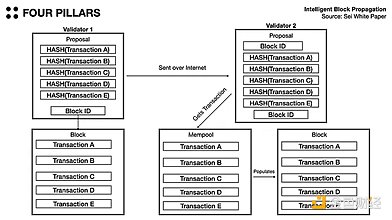
In traditional blockchains, block propagation involves two steps:
(1) When a user initiates a transaction, nodes receive and verify the transaction, add it to their memory pool, and propagate this transaction to other nodes.
(2) Validated transactions are included in a block by the leader (mining node in PoW, block proposer in BFT). Then, this block is propagated throughout the network. Only when all nodes receive this block, the transaction can be considered successfully processed.
However, this traditional approach is inefficient because the same transaction is transmitted twice: first during transaction propagation, and then during block propagation. This leads to wasted network bandwidth.
To solve this problem, SEI Network introduces a mechanism where the block proposer propagates a proposal that contains the transaction hash value and a reference to the complete block, instead of the actual transaction data. The hash value is a summary of the original transaction data processed by a hash function, occupying less space.
The block proposer first propagates the block proposal to the network, and then gradually propagates the complete block in parts.
Blocks are formed without having to wait for the complete block to arrive. If any transactions are missing, they will be processed once the entire block arrives.
SEI successfully improves network performance by approximately 40% using this block propagation process. (In addition, SEI reduces the final confirmation time to 210ms through smart block propagation, mentioned below.)
2.1.2 Optimistic Block Processing
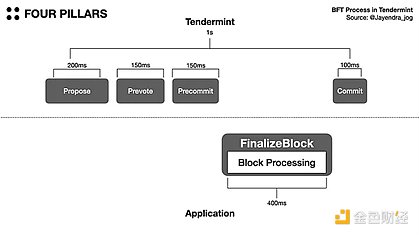
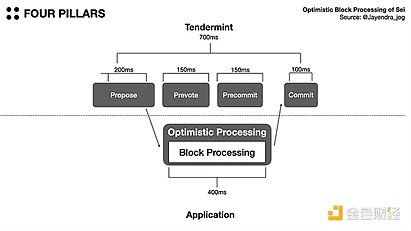
Prior to SEI’s Optimistic processing, consensus on the block must be established before processing the block. However, SEI starts processing as soon as it receives a block, simultaneously processing Prevote and Precommit. This structure may seem to have potential risks, but since Prevote and Precommit processes are also executed during block processing, if the block is deemed invalid during this process, the block can simply be discarded and the process restarted. Therefore, it is not a major issue. SEI Network does not omit the traditional consensus process but processes them in parallel.
SEI successfully improves network performance by approximately 33% through Optimistic block processing.
2.2 Parallel Transaction Processing
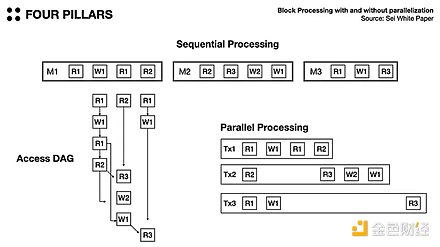
SEI also performs parallel transaction processing with the Twin Turbo consensus mechanism, where it is important to identify which transactions can be processed in parallel. Not all transactions can be processed in parallel, as there are clearly transactions that affect each other. Ultimately, to achieve secure parallel transaction processing, it is crucial to identify transactions with potential conflicts. SEI pre-identifies the relationships between transactions using a directed acyclic graph (DAG). If it is confirmed that these transactions are independent of each other, they can be processed in parallel. Through this method, SEI is able to process 20,000 orders per second.
3. Still craving for speed: How to further reduce the final confirmation time
3.1 What is the final confirmation time? Why is it important?
When calculating the performance and scalability of a blockchain, many people often consider TPS (transactions per second), but in reality, TPS can be a rather vague metric. Here’s an example to explain why. Let’s assume that blockchain A can include 600,000 transactions in one block. But if it takes blockchain A one minute to create a block, then the TPS (= number of transactions in one block / block time in seconds) will be 10,000. However, in reality, since it takes one minute for the network to process the 600,000 transactions, it cannot be considered as processing 10,000 transactions in real-time per second. TPS is just a number that divides the processing capacity of the blockchain by seconds, so the surface-level TPS is different for users.
The example I provided may not be extreme enough, but even if you significantly increase the number of transactions per block and extend the block time to one hour, the TPS can still be very high (although users will have to wait for an hour for their transactions to be included in the network). For this reason, when discussing the scalability of a blockchain recently, TTF (time to finality) seems to be more commonly used than TPS. TTF is an indicator that shows the time required for a transaction to be confirmed. Especially for L1 chains like the SEI network, which focuses on financial transactions, processing transactions instantly and reflecting them in the network is important. Therefore, making TTF as fast as possible is crucial.
3.2 Sei compared to other blockchains
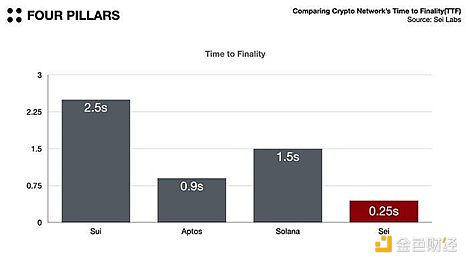
Through the Twin Turbo consensus mechanism (especially through smart block propagation), the SEI network has successfully reduced the final confirmation time to approximately 250ms. This is the fastest final confirmation time among existing blockchains and can actually be perceived by users as near-instant transaction confirmation. Of course, this is the final confirmation time in very optimistic circumstances. After multiple attempts on the SEI testnet Atlantic-2, the most stable final confirmation time was 410ms. They have successfully reduced the final confirmation time to 250ms, but some nodes have difficulty maintaining the network, and infrastructure players such as RPC nodes have fallen behind. This is inevitable because blockchain nodes are inherently decentralized worldwide, so there will definitely be difficulties in propagation and communication. So how can all these nodes be included while reducing the final confirmation time?
3.3 Sei optimization: Still the fastest even in the most conservative cases
To address the above issues, the SEI network has added a commit timeout of approximately 100ms during the consensus process.

Depending on the network conditions, the commit timeout time may be shorter in the future, but for now, in this test network, the added timeout is 100ms. With this, a faster final confirmation time of 380ms can be achieved, while a stable 410ms can be achieved without adding the timeout. Interestingly, even with a 100ms timeout, SEI has achieved the fastest confirmation time among existing blockchains. Depending on future network conditions and adjustments to the added timeout, SEI’s final confirmation time may further decrease. SEI has achieved a faster final confirmation time in a conservative environment compared to other existing blockchains, which is a very interesting fact.
4. The Future Prospects of SEI
In fact, the launch of SEI mainnet has been delayed and has just been finalized. I am not affiliated with the SEI Foundation, so I cannot accurately explain why the SEI mainnet launch was postponed. However, during my research on SEI, I learned that SEI has been making efforts to improve network performance. It seems that they have been postponing the mainnet launch in order to achieve their desired finalization time. Of course, reducing the finalization time is necessary, but what is more crucial is the network’s performance in a stable environment. Over the past year, SEI has been focused on network improvements, delaying the mainnet launch to ensure speed and stability.
Of course, after the mainnet launch, it can be considered as an environment different from the testnet, with many external variables, so it is not possible to confirm whether the performance obtained in the testnet can be directly transferred. However, since the testnet environment is set to be as conservative as possible, it is very likely to achieve a quick finalization time immediately after the mainnet launch.
High stability and high speed – If the SEI network can achieve these two points, it can create an environment where many users can use the chain without any inconvenience. Ultimately, whether it is L1 or L2, a large number of users need to use it to succeed, so the SEI mainnet launch has attracted the interest of many participants in the blockchain industry. As someone who prefers a monolithic blockchain rather than a modular one, I sincerely hope that SEI can succeed and bring a new beginning to L1 competition.
Like what you're reading? Subscribe to our top stories.
We will continue to update Gambling Chain; if you have any questions or suggestions, please contact us!